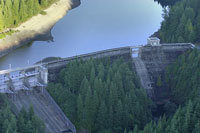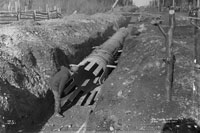Water System Overview
From mountain forests to faucet
Seattle has two large regional watersheds, the Cedar and Tolt. These watersheds supply Seattle and surrounding communities with drinking water, and serve as a home for wildlife and salmon.
Cedar River supply
The Cedar River Watershed is located 35 miles southeast of Seattle. The 90,638-acre watershed supports a diverse ecosystem and provides about 70% of the drinking water to 1.4 million people in the greater Seattle area. From the Cedar River Watershed, melting snow and rain are gathered and stored in the Chester Morse Lake and the Masonry Pool reservoirs created by the Masonry Dam. The dam diverts the water into two large penstocks which drop water 620 feet to the hydroelectric power plant at Cedar Falls, the birthplace of Seattle City Light.
The water is released back into the river, and continues flowing to the Landsburg diversion dam. At Landsburg, a portion of the water is diverted from the river into two large pipelines which run over seven miles to Lake Youngs in Renton. From Lake Youngs, water is pumped a short distance to the Cedar Water Treatment Facility.
Tolt River supply
The Tolt River Watershed is located in the foothills of the Cascades in east King County. It supplies about 30% of the drinking water for 1.4 million people in the greater Seattle area.
The Tolt Reservoir captures water and snow from the Tolt watershed. Most of this water is released from the dam directly to the South Fork Tolt River. A portion of the water is drawn through penstocks to a small hydroelectric facility one thousand feet below. There it enters a small body of water called the regulating basin. The water then continues its journey, all by gravity, to the Tolt Water Treatment Facility.
Water treatment
While we start with a great source of water, the Tolt and Cedar Water Treatment Facilities improve on that source quality in order to meet health standards and our own taste and odor requirements. For more information, please visit the Tolt Water Treatment Facility and Cedar Water Treatment Facility web pages.
Water to your tap
From the treatment facilities, the drinking water enters one of a number of large pipelines known as transmission mains, some as big as 8 feet in diameter. The transmission mains run the 20 miles or more to Seattle and surrounding communities. Transmission mains branch off into smaller pipes, to water storage tanks and reservoirs, sometimes to water pumping stations, and then to you.
Seattle is fortunate to capture its water high in the foothills. Our water flows mostly by gravity all the way to the tap. In some cases, however, pump stations are needed to pump water to hilltops and also to transfer water from one part of the City to another.
Water tanks are located at elevations to supply the right amount of water pressure. The volume of water in the tanks also helps meet the changing needs for water during the day, especially the large amount of water used to fight a fire. At some of our very large in-town reservoirs, we add a bit more chlorine to ensure the safety of the water. From the water tanks and reservoirs, water flows through a grid of water mains, almost 1,700 miles in all, buried below the streets of the City. Smaller water service pipes tap into those mains, bringing the water to you.
History
Wells, springs and private water companies provided Seattle's water throughout the 1800’s. Rapid population growth in the late 1800’s and the “Great Seattle Fire” of June 6, 1889 prompted a vote on establishing a municipal water system, which voters approved by a resounding 1,875 to 51 margin.
Shortly thereafter, Seattle residents approved revenue bonds to construct the Cedar River water system. Water first flowed from the Cedar River into Seattle's system on January 10, 1901. A pipeline channeled water to the Volunteer Park and Lincoln reservoirs on Capitol Hill.
To meet the water needs of a rapidly growing Seattle, the water system capacity grew from 23.5 million gallons per day in 1901 to 68.5 million gallons per day in 1909.
In 1964, the next water supply source, the South Fork of the Tolt River, began supplying north Seattle and the Eastside.
Today, the Seattle water system supplies about 140 million gallons of water per day to about 1.4 million people in the Seattle area.






Website Feedback